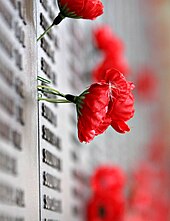
Back يوم أنزاك Arabic Anzak Günü Azerbaijani Deiz an ANZAC Breton ANZAC-dagen Danish ANZAC Day German Ημέρα ANZAC Greek Día ANZAC Spanish Anzac Eguna Basque روز آنزاک Persian ANZAC-päivä Finnish
| Anzac Day | |
|---|---|
 Anzac Day Dawn Service at Kings Park, Western Australia, 25 April 2009, 94th anniversary. | |
| Also called | Māori: Rā o Ngā Hōia[1] |
| Observed by | Australia Christmas Island Cocos (Keeling) Islands Cook Islands New Zealand Niue Norfolk Island Tokelau Tonga |
| Type | Commemorative, patriotic, historic |
| Significance | National day of remembrance and first landing of the Anzacs at Gallipoli |
| Observances | Dawn services, commemorative marches, remembrance services |
| Date | 25 April |
| Next time | 25 April 2025 |
| Frequency | Annual |
| Related to | Remembrance Day |


Anzac Day (/ˈænzæk/; Māori: Rā Whakamahara ki ngā Hōia o Ahitereiria me Aotearoa[2] or Rā o ngā Hōia)[1] is a national day of remembrance in Australia and New Zealand that broadly commemorates all Australians and New Zealanders "who served and died in all wars, conflicts, and peacekeeping operations" and "the contribution and suffering of all those who have served".[3][4] Observed on 25 April each year, Anzac Day was originally devised to honour the members of the Australian and New Zealand Army Corps (ANZAC) who served in the Gallipoli campaign, their first engagement in the First World War (1914–1918).
- ^ a b "Rā o Ngā Hōia". Te Aka Māori Dictionary. Archived from the original on 26 January 2023. Retrieved 18 April 2022.
- ^ "Rā Whakamahara ki ngā Hōia o Ahitereiria me Aotearoa – te Aka Māori Dictionary". Archived from the original on 26 January 2023. Retrieved 26 January 2023.
- ^ "ANZAC Day". Australian War Memorial. Archived from the original on 1 May 2013. Retrieved 24 April 2013.
- ^ "Anzac Day Today". Anzac.govt.nz. New Zealand Ministry for Culture and Heritage. Archived from the original on 27 April 2011. Retrieved 22 April 2011.
© MMXXIII Rich X Search. We shall prevail. All rights reserved. Rich X Search